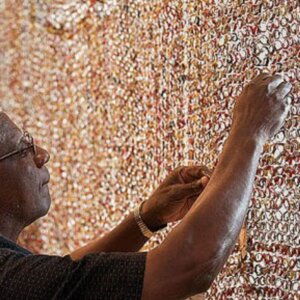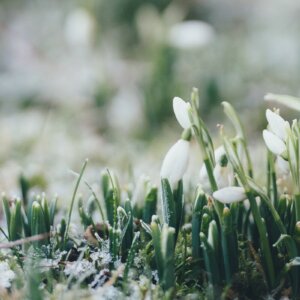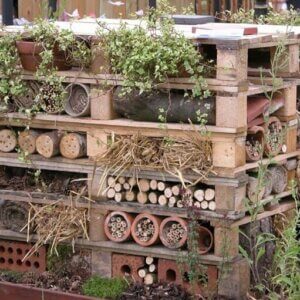Lawns, as we know them, have held their landscaping tyranny over our yards for far too long. Backed by out-of-touch homeowners associations (HOAs), zoning requirements, cultural expectations, and longstanding history of conformity, lawns have kept too many of us out spraying, mowing, reseeding, and weeding for no good reason. It’s time for a change.
Watch The Video
If you don’t want to spend any more Saturday mornings nursing wasteful strips of artificially-maintained grass, you don’t have to anymore. And if you think those unused areas of featureless green would be better used growing something other than grass (like native plants for the original habitat) you’re not alone. A garden should be allowable in a front yard, even if it’s not the norm for your patch of suburbia. More power to you!
There’s actually a huge range of options out there when you decide to break with the green grass goose-step. Let’s talk about it.

The Origin of Traditional American Lawns
Most, if not all of us, grew up with grass spaces available wherever we looked. Even if we lived in a tiny urban lot or an apartment complex, our schools, churches, and businesses were all hemmed in with surprisingly large areas of carefully trimmed and fertilized vegetation. It was so ubiquitous and expected that most of us hardly noticed it at all. But where did this tradition originate?
Well, lawns started out as a status symbol, and they’ve been holding that dubious rank since they were first carved out of the fields around castles. Back then, there was at least some strategic advantage to them. It’s pretty hard to have your army sneak up on an enemy stronghold when it’s surrounded by acres of carefully-trimmed plants rather than a shadowy forest.
In peaceful times, the meticulously cut acres surrounding a home were a public declaration of wealth. In an age without lawn mowers and gasoline, the only way to keep the turf trim was by employing scores of subservient, scythe-wielding serfs (say that five times fast) to do what amounted to pointless work.
For the common folk, lawns were public grazing areas kept trim by willing herds of sheep and cattle. It’s where we get the term “launde” which is an Old English word meaning glade or barren area. You certainly couldn’t brag about monetary accumulations as the lords did — the animal manure was the dead giveaway — but there was probably no denying the pleasure of strolling unimpeded across a gently rolling hill.
Fast forward to the New World, and the lawn continued to be held as a status symbol. Thomas Jefferson famously developed them around his Monticello estate, and the trend continued to spread. When America started developing and modernizing its cities, the inevitable train of suburbs sprawled out from them, and with them came that perfectly-trimmed, and bright green space of grass. Depending on your opinion, you can thank or gripe at Abraham Levitt and his sons for embedding an immaculate green, weedless, carpet of turf into the white picket fence psyche of the past six decades or so. He was a key part of pioneering the suburban conformity we still uphold.
In our modern day, keeping up with the Joneses and their perfect patch of fescue has become the middle-class attempt to pretend to be the old fancy lords (whom they probably don’t realize they are emulating). Lawns are a booming business. In 2020 alone the industry raked in 10.5 billion to keep those largely useless patches of green as lush as possible. Turf grass is the most widely-grown “crop” in the United States, covering more than 40 million acres of land. In a darkly funny case of history repeating itself, plenty of folks are still following the same actions of those serfs from the middle ages, expending time and resources to pointlessly care for plants that neither feed nor house them.
But we’ve taken it much further. In addition to spraying scores of pesticides and fertilizers to keep that freakily verdant grass bright no matter what the weather, the U.S. now uses one-third or more of their available freshwater to care for lawns.
I want to repeat that fact…at least one-third of our drinkable water isn’t used to grow food, water livestock, or give thirsty people a drink. It is used to water non-native, nonfood swathes of grass that are chemically forced to stay a monoculture and cropped weekly by gas-guzzling machines. All to preserve a status symbol. In volume, that translates to nearly 3 trillion (yes, that’s trillion, with a T) gallons of water a year.

As you may expect, many environmental activists, so-called “experts,” and eco-conscious journalists have sounded the alarm that it’s time to abolish the lawn in its entirety; referring to them as “ecological dead spaces” and declaring that we need to replace them with native species or else we’re “in big trouble.” But for the purposes of this article, I have a different approach.
I don’t want to get rid of the lawn, and I hope this article doesn’t come off as another guilt-ridden judgment on the hapless public. I just want to get rid of unused areas of artificially maintained and pesticide-sprayed grass, and offer some options. Because the truth is, if you do have a lawn, however big or small, you have a space of dirt that is chock-full of exciting potential. And being motivated by the thrill of a new endeavor is a better force than being motivated by guilt.
So if you feel done with the expense and waste of the useless grass-growing game, there’s a world of choices available. Let’s take some scenarios, case-by-case, and see which one may work best for you.
Kids and Pets-Safe Home Lawns
I find that the ecological conversations surrounding the abolition of yards are often devoid of a very crucial question — where are the kids supposed to play and safely enjoy the outdoors? Where are the dogs supposed to stretch out in the sun with their bellies to the sky? Where are the families supposed to make a cozy backyard campfire, filling the air with laughter and stories? What’s the use of having some magical eco-backyard full of native perfection and indigenous shrubs if no one can enjoy it?
So let’s get to two simple tips that make sense. First, stop spraying your backyard. Are you able to let go of the bragging rights of an Astroturf-like space of uninterrupted green? Eventually, other plants will start to populate the area. Clover will sneak in, dandelions will raise their sunny little heads, and henbit will decorate the margins. Less chemicals in your world means healthier soil, healthier water, and much, much healthier little bare feet.
Second, mow less frequently. Over frequent mowing interrupts the natural growth cycle of grass, resulting in stunted root systems that can’t deal with drought or flooding nearly as well as they should. And if you do have to replant, use grasses native to your area — look at this comparison between root systems!
Low Maintenance Home Lawns
Some of us want to spend our precious days doing something other than landscaping. Or, some of us may have to deal with chronic pain, increasing age, or the care of something more important than our turf. For these folks, I’d like to recommend checking out our earlier article on alternative ground covers. Though some of them will need a bit of effort to get established, once in place, the plants in our list require no mowing.
Wildlife Habitats Home Lawns
The National Wildlife Fund offers certification for yards that want to be converted into Certified Wildlife Habitats and gives plenty of great information on how to do it.
The Audubon Society offers a similar program to folks wanting to get their backyards certified as habitats. You’ll have to do some research to find your own local program.
Garden Space Home Lawns
As ridiculous as these decrees sound to folks who want to grow their own food, dealing with the threat of fines may be a turnoff to those trying to change turf into tomatoes. There are several ways to approach this.
For the devil-may-care crowd, I suggest putting in a garden in the best, sunniest spot you have on your property. Some say it’s better to ask forgiveness than permission. Fence it in, if necessary, to keep it safe from curious sidewalk kids (sometimes they do steal hot peppers for dares). Do a really good job, and make it beautiful. If you feel extra bold, deliver a small basket of pretty tomatoes to the head of your HOA to confuse them. And if you find that you need to fight this fight to grow your own food, there are plenty of stalwart folks with dirt on their hands who have gone before you.
For those looking to fly a little more under the radar, try edible landscaping (and check out our earlier article on the topic here). Or hide a garden in plain sight. Who says your window boxes can’t have a full palette of kitchen herbs? Would anyone fight you over the beauty of some flowering burgundy okra or red garnet amaranth, gracefully towering over some multi-colored, bright lights Swiss chard, with the purple pom-poms of onion flowers nodding in agreement? Train cucumbers to climb up the patio and surround the mailbox with the beautiful foliage of sweet potato vines. Most passers-by would think you’d landscaped with some really exotic plantings.

For those looking to be more covert, plant fruit trees and native edible shrubs in your front yard. To the botanically illiterate, they’ll look like they’re just another planting of some random bush-thing, but you know that they’re full of future good eating. Investigate if your state offers native, bare-root seedlings — sometimes, these plants cost less than a dollar each when sold from nurseries maintained by departments of conservation.
You know that low, boggy area of the yard that always turns into a brown, grass-killing puddle every time it rains? Stop fighting it. It’s begging to be converted to a rain garden, a mini-wetland that soaks up runoff like a sponge can be populated with gorgeous native plants, and it will save you money on reseeding.
You know how you’ve spent so long with that sprinkler system or hose, trying to keep your poor, drought-stricken yard from succumbing to the same dry weather every summer brings? Stop fighting it. Maybe your area’s climate was never designed to support that non-native grass. Find out what wants to grow there no matter the rainfall (giving your state’s department of conservation a call will point you in the right direction) and see about replanting with species that can handle drought like champs. Try researching the term “xeriscapes” and you’ll be amazed by the varieties that can fill a dry yard that doesn’t naturally support grass.
Do you know that shady area that always seems to end up sparse and patchy? Stop trying to plant species that need full sun there … like grass. Instead, a shade garden could be a much better fit. Check out our earlier article on plants that were made to thrive in the shade, and bring a bit of the secretly beautiful forest understory to your growing patch of paradise.

I could go on, but you see the point. If grass isn’t working for some reason, why keep trying to make it work?
Growing Your Own Food on Your Land
I offer you the book “Food Not Lawns” available for free here. Written by folks who originally worked with the “Food Not Bombs” program, you may correctly guess that this book is not only about growing a garden where grass once stood. With a heady mix of community building, anarchistic anti-war sentiment, seed saving, and food growing information, you’ll probably find a lot to consider, a bit to disagree with, and plenty of information to help you play a part in changing and unifying your local neighborhood.
No Land, No Problem
Just because you’re living in an apartment complex doesn’t mean that you’re doomed to sit on your gardening hands. If there’s a useless lawn somewhere in your weekly route, see if you can give it purpose. Contact the church groundskeeper, the university’s chief of landscaping, or the janitor at work. See if there’s some way you could turn it into something useful. It’s likely you’re going to hear the word “no” quite a bit. But there is a chance someone could give you the go-ahead to start an unlikely garden or fill the area with native flowers that don’t need as much maintenance. You won’t know until you ask. Just be sure to back up your request with the gumption to get it done.
And at the very least, see if there’s a community garden in your area. Or, find out if you can garden in that abandoned lot — some cities offer programs supporting such efforts. In many cases, community gardens, abandoned lots-turned-paradises, and other such inspiring locations get started because one bold, motivated person asked “Why not here, now? And why not me to do it?”
How Businesses and Public Centers Can Use Their Lawn Space
It’s time to change the perceptions of corporate perfection that is based on having that perfect carpet of green with the “don’t walk on the grass” sign posted menacingly by the parking lot. Let folks walk on the grass. Let the apartment dwelling employees or the local 4-H club, cultivate a garden in the corner. Turn that boggy spot into a native plant-filled wetland again, instead of installing yet another one of those fenced-in, sterile drainage ponds ringed with concrete. If you run a food pantry, consider how much more influential and nutritious your work would be if you offered fresh food from your actively used acreage.
Let a corner be transformed back into a meadow, complete with explanatory signs patting yourself on the back for being nice to nature. Most businesses have a landscaper or hire out a team already, so it’s not like you’d be adding something new — but you’d certainly be making something different.
Whatever you choose, try to do something better than making that boring old turf the continued norm. It will make your establishment interesting and give the local news something positive to chatter about for once.










































Funny you guys talk about the environmental impact of lawns and then tell people to go plant fu–ing lily turf.
I’m assuming this comment is because some of it can be invasive. There are both spreading and clumping varieties, but we’ve added a caution/note into our ground covers post about it.